Steaks have become a popular dish all over the world, with many countries developing their style and method of preparation. It is cooked anywhere - from professional kitchens to domestic ones.
In this article, you are provided with a very comprehensive guide to steaks – from the sauces, seasonings, recipes, step-by-step procedures for different cooking, to some of the facts and trivia that you may not know about.
More...
Overview of Steak
Beefy and super delicious, steak has been one of the most favorite dishes in many different countries. It has an appeal beyond the average meat you have in any restaurants or any kitchen. What is steak, what are the dishes you can cook with this meat, and what are the things you may not know about it?
- THE TASTE
What is Steak?
When we think of a steak, we always imagine a big blood colored meat framed by fats and juices. When it comes to steak, it is always the bigger, the better.
Steaks do not only refer to beefsteak. While it is true that the word “steak” is referred to beefsteak – a cow meat; however, steak recipes can be made with fish meat, pork meat, deer meat, and even chicken meat.
The word itself originates way back 15th word “steik,” which Oxfords defined as a “thick slice of (any) meat that is cut for grilling, roasting, frying; especially refers to the cuts on the hind-quarters of (any) grazing animal, generally cow. It is specially made from a meat sliced perpendicular to the muscle fibers together with a bone, usually found in the middle.
The steaks you know can be in any forms. It can be grilled, broiled, pan-fried, or it can be seared with different kinds of special sauce.
Side Dishes To Eat With Steak
There is a LOT of side dishes you can have with your steaks. This includes the following:
Roasted sweet potatoes | Potatoes have been one of the most “familiar” side dishes with meats. Here, you can season with cilantro pesto to make it more flavorful. |
Broccoli salad | In this recipe, you are going to put some raisins, sweet mayonnaise dressing, peanuts, and ramen noodles to eat with your steak. The light flavor of the broccoli salad complements well with the steak. |
Crispy potatoes | Crispy potatoes as your side dish are one of the traditional away of enjoying your steak. In this recipe, you can season salt and vinegar to give some punch of sour and briny taste that completely blends with the salty steak. |
Grilled Radicchio | Another famous and “fitting” side dish of your steak is the grilled radicchio. Here, you can put some cheese to make it creamier that blends with the naturally bitter taste of the radicchio. |
Roasted green beans | Beans are traditionally served with different kinds of meat especially steaks. You can steam or sauté your green beans and give it some harissa, olive oil, and black pepper, and everything will complement with your meaty steak. |
For more side dish recipes, read 27 Side Dishes that Go Great with Steak.
Steak Facts: A Few Things You Probably Didn't Know
We all know that steaks taste so delicious that it is often ordered, served in restaurants and often enjoyed at home in any occasions. Below are the things you might not know but need to know about steaks:
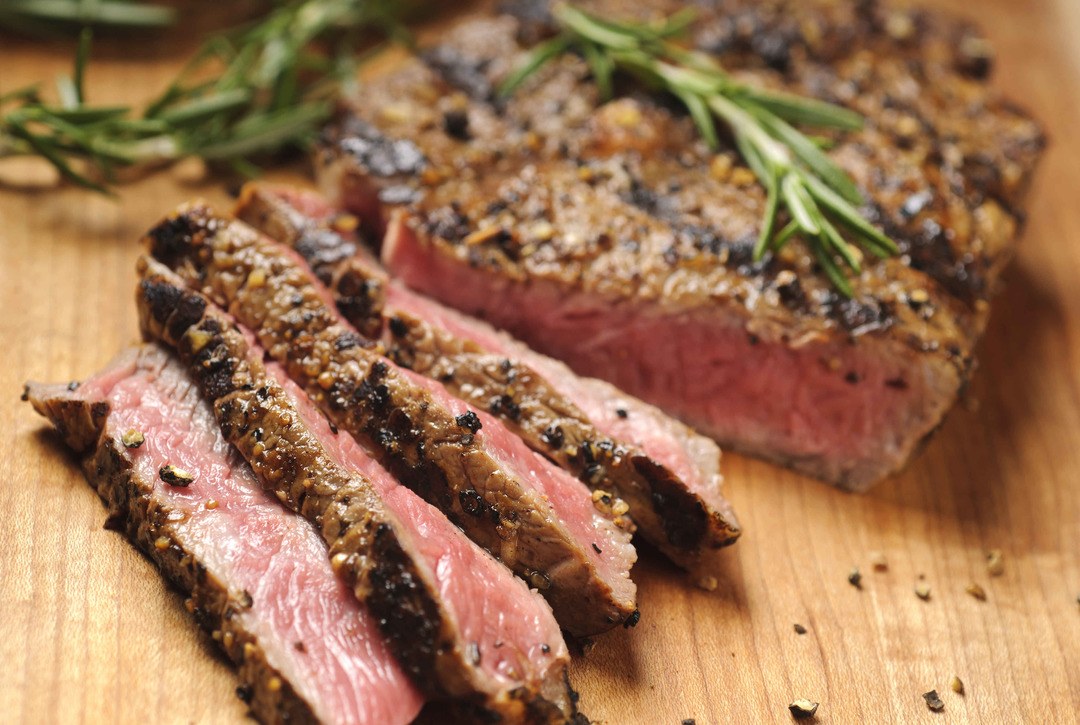
- Overcooked steaks taste bad and are bad for you. When the steak is overcooked, the heat provokes the fusing of the sugars and proteins, which potentially makes your meat tough, difficult to cut and eat, and apparently difficult to digest. Aside from this, overcooked meat is linked to cancer. This is due to the carbon build-up caused by high heat. This is especially experienced from the burns that charcoal heat provides.
- Goodly cooked rare steak does not give you blood. You need to know that it is not blood. The juice that you get from rare steaks is made of mostly water, fats, and proteins called myoglobin. This gives the meat a pinkish color. So you do not need to worry.
- There are sixteen different cuts of steak. Well, if you have only eaten one to three kinds of steak cut, you need to know that there more than those do. These include Rib, Blade, Sirloin, and other combinations like T-bone and others.
- Certain types of steaks require a certain amount of heat. This means that each type of cut and each type of meat needs to be cooked differently. For instance, thicker steaks require to be booked at low heat for a longer period, and a rare steak needs lower cooking temperature than well-done steaks.
For more steak facts, read 10 Things You Need to Know About Steaks
A Complete Guide to Cook Steak
What Cuts Should You Choose?
Types of Steak Cuts
As mentioned, there are approximately sixteen primary cuts of steaks. However, here, we will be discussing some cuts that are popularly used, and that produce good steak meats.
Rib | This cut is popular because it produces a juicy, tender, marbling and flavorful various cuts, which include prime rib, rib-eye roast, and short rib. They can be best cooked with dry heat for a longer duration. They give a robust taste. |
Brisket | This is from the breast, has more connective tissues and a bit difficult to cook. It produces two kinds of cuts such as the brisket flat and point cuts. They best cooked by braising or by smoking. |
Chuck | This cut is also called as “seven bone steak” that is completely reflective of its structure and bone shape. It is located near the neck and shoulder. The specific type of chuck cuts includes chuck arm roast, flat iron steak, and chuck roast. These cuts have move connective tissue and thus might be difficult to cook. However, they also provide good strong flavors. They can be perfectly cooked in slow cooking at low temperature. |
Sirloin | This cut is past loin and is considered as the second most tender cuts. This specifically produces certain cuts like the top and bottom sirloin, center cut sirloin, filet sirloin, tri-tip steak, etc. and is best cooked in any cooking procedures like broiling, grilling, sautéing or pan-frying. Because it is good meat, this can be very expensive aside from the loin. |
Loin | This is cut from the hindquarter behind the cow’s ribs and is known as one of the most tender cuts for steak and beef dishes. Specific cuts include T-bone steak cut, porterhouse, etc. and is best cooked over dry heat. |
Round | This cut is also known as rump cut. This is a lean meat cut with little fats on it. It can be found at the back and near the cow’s leg. This can be tough when cooked because of the consistent moving of the cow’s legs when it’s alive, making the muscles more sturdy. Specifically, it produces cuts like round roast and sirloin tip center roast, and is best when braised with a small amount of moisture. |
For more types of steak cuts, read Different Kinds of Beef Cuts
How to Select The Right Cuts
Any cut that has “loin” or “rib” in it would make a very tender, flavorful, even without marinating. Some other cuts like chuck and round need to marinate since their muscle fibers are stiff and sturdy. The thickness and the area where it is cut are the two primary factors that affect the quality of meat it provides.
The following are the cuts especially sliced for cooking steaks. Each has its pros and cons, which depend on several factors such as the taste, thickness, where it is cut, the flavor it gives, the amount of fat it has, and the price it costs.
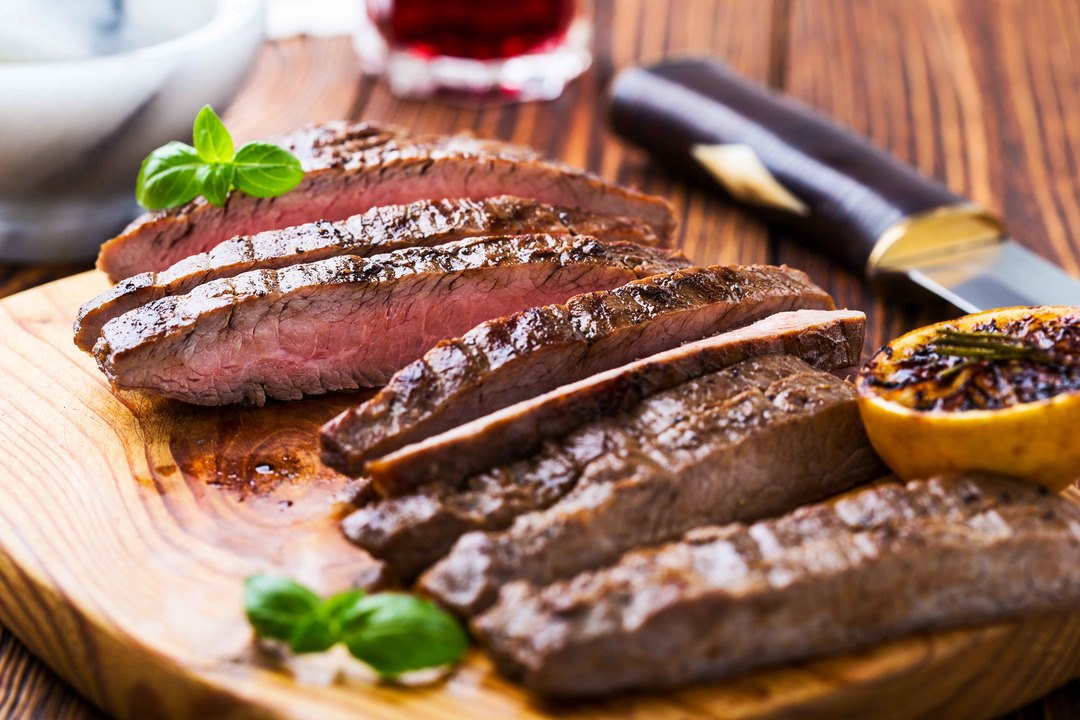
Chuck and Round cuts | These cuts are usually larger and stiffer. Chuck is located near the shoulder while the round is located near the cow’s legs. They have a few fats and can be difficult to cook. This is due to the consistent moving of the cow’s muscles when it is alive. The muscles are sturdier, creating a tough meat for steak. Because they are larger and can be hard to cook, they are usually the cheaper. Although they need to be marinated so long to make the meat tender and the flavor to burst out, they can still make good steaks, with the right marinade and cooking procedure. |
Brisket | This is another tough meat, located near the chuck, specifically on the lower portion, It has many connective tissues that make it hard to cook. However, this is also a cheaper meat compare to other cuts. |
Sirloins, loins, filet mignons | These cuts are the most tender of all cuts, the tenderloin ranking no.1. Sirloin, in general, is not as tender as the short loin since the muscles are used more in this area. Although these parts do not have powerful flavor on their own and marinating them is a must. They can be expensive compared to chucks and rounds, but less expensive that the rib-eye cuts. |
Rib-eye | This cut is another popular cut because it gives a tender, juicy, and flavorful cuts such as the rib steak and scotch filet. Their marbling and fattiness of rib-eye cuts make them very ideal for slow-roasting and grilling in different temperatures. These cuts are more expensive than the sirloins and strips. |
Tip: Look for thick cuts, no thinner than one inch. If you choose thinner cuts, then you would be more likely overcook your meat.
For more cuts information, read Get to Know Your Cuts of Steak from Yummly.
How to Buy a Good Steak
Cooking steak might look easy. However, there is one mistake that most wrongly do – buying a not-so-good quality steak. Here, you will know how to buy a good steak meat meticulously and how to make most of what you bought.
Distinguish Grades: Prime, Choice & Select
When referring to the cuts of beef, you probably heard some words like “Prime,” “Choice” or “Select.” These are the USDA Beef Quality Grades of meat. The Graders look for two primary factors:
- the quality of juiciness, flavor and tenderness
- the amount of usable lean meat on the carcass.
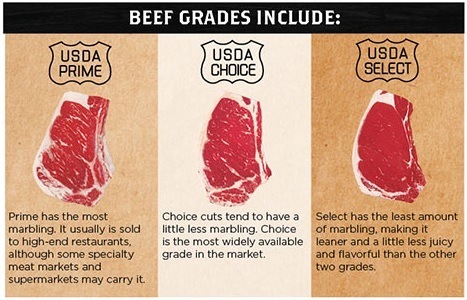
Beef quality grades via Beef to live
USDA Prime Beef | This cut is produced from young, well-fed beef cattle. It has abundant marbling and is popular in many hotels and restaurants. This is considered to have the highest quality and intramuscular fats. |
USDA Choice Beef | This is a high-quality beef but has less marbling compare to the first grade. This is widely available in retail marketers and foodservice. Another difference between the prime and choice grades is the amount of fat content in the beef. Choice beef has lesser fat content than Prime beef. |
USDA Select Beef | This meat is the scored the least among the three. It may have lesser juice and less tender than the Prime and Choice beef, due to less marbling. |
How Marbling Effects To Flavor And Cooking Of Steak
Marbling refers to the white flecks and streaks of fat within the meat. The more marbling, the flavorful and tastier the meat is. This is why most chefs prefer meats like these.
The marbling is determined by the diet of the animal. Grain-fed animals produce more marbling meats than grass-fed animals. This is why you cannot see grass-fed meats graded as prime.
Again, this adds to the flavor when you cook your steak. Aside from this, since this is fat, your meat would produce/give off more juice when cooked, especially when it is grilled.
Grass-fed vs. Grain-fed
As mentioned, grass-fed cows do not produce more fats and marbling. This means that your meat would yield medium-level fats and juice. On the other side, grain-fed cows produce more marbling meat and are considered to provide tastier cuts.
However, tossing “flavor” and “taste” criteria aside, you might be surprised to know that the grass-fed meats are healthier than the other. When we say that one food is better than the another, we need to prove it contains more nutrients and fewer toxins.
Grass-fed meat has these criteria. It has more antioxidants, omega-3. TVA, minerals, vitamins and much more. While it is true that grain-fed meat produces more flavor, the fats it contains can be dangerous to your health.
Precut Steaks or Cut Them Yourself?

This is a matter or price as well as skill. Buying a whole cut and cutting the meat yourself can be cheaper that buying pre-cut meats. However, when you choose to cut the meat yourself, you need to have the skill and the equipment such as sharp knives to perfect the cuttings. If you are not too skillful in cutting meats perfectly, don’t worry, it is a skill – it can be learned. Read Keko's instructions for slicing different kinds of steak meats.
However, if you can spend the extra cash for convenience, you can always prefer precut steak meats.
Bone-in Vs. Bone-less
For many years, there have been many debates about how the bone within the meat affects the quality of flavor. Thankfully, new research and studies found out the answer to this debate.
The majority of chefs, meat-lovers and grillers would tell you that your steak would taste better with the bone in it. This is because the flavor trapped inside the bone transfers to the meat as you heat and cook your steak.
All bones of animals contain marrow. In steak, for instance, you are provided with red and yellow marrows. Yellow marrow gives off delicious flavor that some would call it “prairie butter.” When you cook the steak, this yellow butter will melt, giving your meat a smoother and buttery flavor.
How To Prepare To Cook Steak
Whether you are cooking a butter-fillet steak, rum, skirt or sirloin steak, you need to exercise care and attention when cooking your steak. You also need to pat attention to your equipment.
Tools You Need
Aside from the common tools you need when cooking, the following are the primary needed materials for cooking steaks:
Cast-iron skillet |  Lodge Cast Iron Skillet, 13.25-inch via Amazon | When it comes to the fryer pan, we recommend a heavy-duty, thick-based frying pan. This is because your steak needs to be cooked at a very high temperature. Save your think non-stick pan for your bacon and eggs. Steak needs more than that. A good cast-iron skillet is ideal for this job. |
German-style knife |  Muela German Style Utility Knife via Amazon | When you slice cuts of meat, you need to have a sturdiest and the sharpest knife you can have. This is to make sure that you make a clean cut to whatever part of meat you like. |
Thermometer |  Meat Thermometer via Amazon | While it is true that you can use your palm to check your steak, the thermometer is the best tool to make sure you are not just guessing. In fact, most people, especially the non-chefs need to use a thermometer to achieve the desired style of meat. |
Aluminum Foil |  Reynolds Wrap Aluminum Foil via Amazon | It is always better to rest your steak while it is wrapped with aluminum foil. This ensures that the juice and the heat are preserved within the meat |
Heat Sources To Cook
You can use any kinds of a tool when cooking steaks. From stovetop to charcoals, there is a lot to choose from.
When you use an oven, take note of the following heat temperature:

Oven heat temperature via Omaha Steaks
When you want to grill your steak, you can do this by a gas grill or charcoal grill. Although charcoal grilling would be the choice of most people because it gives a perfect smoky flavor to the meat.
Always remember that when you use a broiler or any gas fire, turn the temperature at its highest to give your steak that crispy crust.
Prepare Steak before Cooking
STEP 1 | Thaw the steak if it has been kept in the freezer. Do not eat meat that has been put in the freezer and thawed twice. |
STEP 2 | Choose a steak cut that is at least one-inch thick to achieve the medium, medium rare doneness. |
STEP 3 | Rest the steak before preparing it for cooking. You can do this for up to 20 minutes. |
STEP 4 | Cut off some bones or fats, if you prefer. |
STEP 5 | Coat it with a thin layer of oil |
STEP 6 | Season your steak. You can use your recipe or use the recipe we provide in this article. |
STEP 7 | Decide on a cooking time duration before you cook your steak.
|
How to Season Steak
Basic seasoning
Here, you only need the basic ingredients for seasoning your steak – salt and black pepper.
- Step 1: let your steak reach room temperature. Before seasoning your meat, make sure that you pat dry it with paper towels.
- Step 2: Season it with salt and pepper (1 tsp per pound) on each side. Salt it 40 minutes before cooking it. The salting process also tenderizes the meat by breaking down some protein.
- Step 3: Brush some oil. Most chefs would prefer some olive oil because it has a distinct, crisp flavor that they love. Some would prefer canola or groundnut oil. Use oil no more than one teaspoon for each pound.
- Step 4: Apply salt and pepper just after you cook your steak. Always use freshly ground pepper
- Step 5: Enjoy!
Seasoning combinations
Here, all you need to do is to combine all the recipe and rub onto your steak. We will provide you two of the most used and popular herb and spices combination. Always remember that you can always experiment and add your preferred spices and herbs.
Montreal Steak Seasoning
Ingredients:
- 1 tbsp paprika
- 1 tbsp crushed coriander
- 1 tbsp dill
- 1 tbsp crushed red pepper flakes
- 1 tbsp granulated onion
- 1 tbsp granulated garlic
- 2 tbsp freshly ground pepper
- 2 tbsp kosher salt
Turmeric-based spice blend seasoning
Ingredients:
- ¾ tsp onion powder
- ¾ tsp garlic powder
- ¾ tsp ground coriander
- ¾ tsp turmeric
- ¾ tsp cayenne pepper
- 1 ½ tsp ground black pepper
- Two tsp paprika
- Four tsp salt
Read more: Ways to extending the garlic's life.
Ways to Cook
There are many ways to enjoy your favorite steak. You can grill, pan-fry, sear, and broil --- with many recipes for each style of cooking. The following are the comprehensive procedures on how to cook your steak in many different styles.
- How to Grill Steak
- How to Broil Steak
- How to Pan-sear Steak
- How to Make Sous Vide Steak
- "Afterburner" Steak Method
- How to Coal Roast Steak
- Bare-naked coal Method
- Steak Tartare Method
How to Grill Steak
One of the most popular cooking styles of steak is grilling. How to cook grilled steak? Find out how.
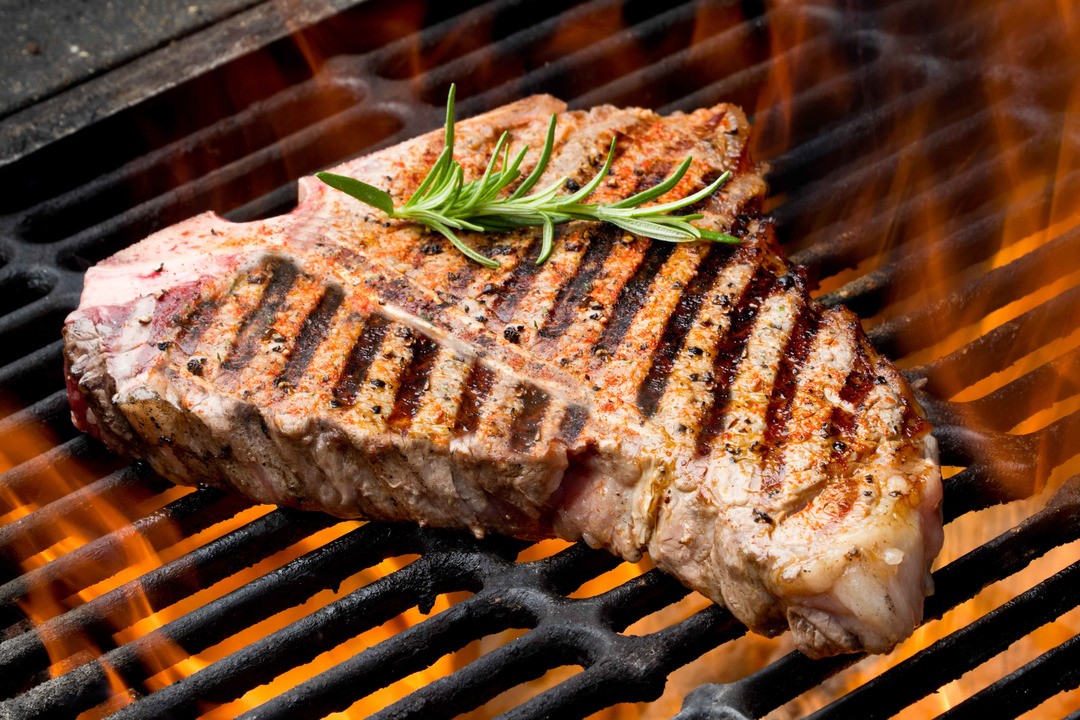
Equipment:
- Hardwood charcoal
- Griller
- Thermometer
- Tongs
- Plate
Ingredients:
- Steak
- Marinating ingredients (you can use your ingredients)
- Salt
- Pepper
Procedure:
STEP 1 | use hardwood coals rather than briquettes, because they heat faster and hotter. Do not use lighter fluid in lighting your coals, use bbq chimney. |
STEP 2 | Arrange the coals one the other side of the grill. |
STEP 3 | Assuming you have seasoned and rubbed your meat with the ingredients we provided above, it is now time to start cooking your meat. Start cooking on the cool side of the grill – start, where there are no coals, are resting. Let it cooked through indirect heat. |
STEP 4 | Flip to develop the crust. Still, stay on the cool side of the grill. Use your tongs for flipping consistently after few minutes your steak to achieve the crust. Steaks that are flipped open appear to be juicier. |
STEP 5 | Check inside temperature. Do not just guess. It is always better to use thermometer than to use palm. The following are the temperature for doneness:
|
STEP 6 | when your meat is just 15 degrees below the ideal temperature, sear both sides using very high heat. This is to develop that crispy, brown crust that all perfect steaks have. |
STEP 7 | Rest your steak after removing from the heat. Rest it within 5 to 10 minutes. |
STEP 8 | Season your steak with salt and pepper, or with your seasoning recipe (or pour the sauce if you have cooked some with your preferred ingredients) |
How to Broil Steak
Equipment:
- Rack
- Roasting pan or grill pan
- Tongs
- Microwave oven
Ingredients:
- Steak meat
- Pepper
- Salt
- Seasonings
Procedure:
STEP 1 | Position the rack four to six inches below the top of the oven. If you want the meat to be a little rare, put the rack down at six inches. If you want it to be well done, then you should position it at four inches near the top. |
STEP 2 | Turn on the broiler |
STEP 3 | Put a large cast-iron skillet inside the oven and preheat for 15 to 20 minutes. |
STEP 4 | After pre-heating, place the steak onto the pan and broil for about three minutes at a high temperature. Flip the steak and broil the other side for another three minutes. |
STEP 5 | After the three minute broiling on each side, turn down the oven to 500 degrees Fahrenheit. |
STEP 6 | Cook the steak according to this chart. |
STEP 7 | Season with salt and pepper or with your seasoning. |
STEP 8 | Let it rest within five to ten minutes |
How to Pan-sear Steak
Equipment:
- Cast-iron skillet
- Tongs
- Thermometer
Ingredients:
- Steak cut
- Salt
- Pepper
- Butter
- Seasonings
Procedure:
STEP 1 | Heat your cast-iron skillet at high heat heavily smoking |
STEP 2 | Spread out two tablespoons of oil in the skillet |
STEP 3 | Put the meat in the pan and pay attention to the placement if pan has raised ridges |
STEP 4 | Flip it consistently within six to twelve minutes or until desired internal temperature is achieved.
|
STEP 5 | Few minutes after doneness, put some butter or other aromatics and seasonings like garlic, sage, etc. |
STEP 6 | Rest the meat after taking it off from heat, preferably within five to ten minutes. |
STEP 7 | Pour your sauce and enjoy! |
How to Make Sous Vide Steak
Ingredients:
- 1 (8-12 ounce) boneless rib-eye, tenderloin, or strip steak
- Kosher salt
- Freshly ground black pepper
- One tablespoon of virgin coconut oil
Procedure:
STEP 1 | Set the Anova Sous Vide Precision Cooker to 130 degrees Fahrenheit |
STEP 2 | Season your meat with pepper and salt, or with your preferred spices and herbs. Put the mixture and steak into a resealable bag. |
STEP 3 | Place the bag into a bowl of water and the timer for two hours. |
STEP 4 | After two hours, pat dry the meat. |
STEP 5 | Prepare the skillet and heat at high temperature |
STEP 6 | Put the oil and wait until it becomes very hot |
STEP 7 | Put the steak and sear until well-browned (30 seconds). Flip over and sear the other side for about 30 seconds. |
STEP 8 | Transfer the meat onto the cutting board and let it rest within five to seven minutes.  Steak-donenesses via Chefsteps |
"Afterburner" Steak Method
Equipments:
- Griller
- Tongs
- Coals
- Thermometer
Ingredients:
- Steak cut, preferably hanger, flank or skirt steak (3/4 inch thick)
- Salt
- Pepper
- Seasonings
Procedure:
STEP 1 | Fire up your chimney starter. Half-full coals, and not completely loaded to the top. |
STEP 2 | Pat dry your meat and coat with thin oil |
STEP 3 | Season with salt and pepper or with your preferred seasoning ingredients |
STEP 4 | Put your steaks on the grill |
STEP 5 | Sear each side for one minute or until desired doneness is achieved. Check with a thermometer. |
STEP 6 | After getting from the grill, let it rest for five minutes |
STEP 7 | Enjoy with your steak sauce! |
How to Coal Roast Steak
Equipments:
- Oven
- Tongs
- Thermometer
- Cast-iron skillet
Ingredients:
- Steak
- Salt
- Pepper
- Seasonings
- Roasted garlic pure ingredients
Procedure:
STEP 1 | Preheat the oven to 450 degrees, and put a large cast-iron skillet over medium heat until it becomes very hot. |
STEP 2 | Film it with a small amount of oil, until the surface, is thinly covered. |
STEP 3 | Season your steak with salt and pepper or with your preferred seasoning recipe |
STEP 4 | Sear for about two to three minutes on each side. |
STEP 5 | Transfer the steak to a baking sheet and put it in the oven |
STEP 6 | Cook for 8 minutes for each side |
STEP 7 | Remove the steak from the oven and let it rest for at least fifteen minutes before putting some roasted garlic puree. Return the steak to the oven and cook for three minutes. |
Bare-naked coal Method
There are times when we just want to some hot chunk of a charred meet in a Neanderthal way of cooking and eating. Bare-naked coal method is where you put the steak immediately on the very top of the coals – without any grilling screens and racks.
Equipments:
- Grill
- Tongs
- Foil
- Natural lump coals
Ingredients:
- Thin skirt steaks
- Pepper
- Salt
- Preferred seasonings
Procedure:
STEP 1 | Prepare your steak. Season with pepper and salt, or with preferred marinade or rubbing recipe. Put into the fridge for at least one hour. |
STEP 2 | Put some charcoal on your grill, enough to cover the bottom portion of your grill. We recommend you to use natural lump charcoals. Wait until it gets ready (glowing without flame). |
STEP 3 | Place the steak directly into the charcoal for 35 to 40 seconds aside. |
STEP 4 | Remove from the heat and wrap well with foil |
STEP 5 | Let it rest within five to seven minutes. |
STEP 6 | Slice across the grain and enjoy! |
Steak Tartare Method
Ingredients:
- 3 oz finely chopped beef fillet
- One free-range egg yolk
- Salt and pepper
- Two finely chopped gherkins
- One tsp finely chopped capers½ tsp Dijon mustard
- Tobasco sauce½ tsp Worcestershire sauce
- One finely chopped shallot
Procedure:
STEP 1 | Place the chopped gherkins, capers, shallots and beef into a bowl. Mix thoroughly. |
STEP 2 | Put the mustard, tobacco sauce and Worcestershire sauce, ground pepper, and salt. Mix well. |
STEP 3 | Spoon some mixture onto a slice of plain pumpernickel bread. |
STEP 4 | Create a tiny dent on the top of tartare and put some fresh egg yolks. Eat as soon as possible. |
Best Sauces To Cook Steak

Chimichurri | South American cousin of Salsa Verde, this sauce will give your steak a tangy herb flavor that will perfectly blend in with the salty ad meaty taste of your steak. |
Salsa Verde | Salsa Verde is an Italian green sauce that doesn’t need to be put on heat. Just mix all the ingredients and ta-da! You now have an herby sauce for your meat. This sauce is composed of some chives, parsley, and mint together with anchovies, and capers. |
Béarnaise sauce | This sauce is perfect especially when you want your steak to be topped with a creamy and thick mayonnaise-like sauce. |
Blue Cheese sauce | Steak and blue cheese is a match that you cannot resist. Combine it with your favorite wine, and you will have the ever-elegant meal you could ever have. Blue cheese sauce is just very easy to make – you only need some butter, flour, milk and your blue cheese, and you’re good to go! |
Mushroom sauce | The mushroom sauce is popular not just for steaks, especially the retro-style grilled mushroom. However, in this recipe, you will make a very creamy sauce to match your meaty steak. |
Tips and Tricks
Tips to Check The Steak Doneness Using Your Palm

Check The Steak Doneness using your palm via Mobile Cuisine
Of course, if you want to be precise with the steak doneness, the best method is to use heat thermometer. However, if you don’t have any, you can always use this trick. You can determine the steak’s doneness through comparing the steak’s elasticity to the way how your lower portion of thumb feels when its reflexes.
Guide:
Touch your thumb to your index, middle, ring, and pinky fingers. Your muscles become harder as you reach farther from your index finger. This associate to the rare, medium-rare, medium and well-done steaks.
PLAY VIDEO to watch full tutorial.
Resting Steak
There are two reasons why you need to let your steak rest after removing from the heat. First, it gives more flavor and the second; it makes the cutting easier. When the steak is newly removed from the heat, the juices gather near the surface, making the steak overly tender. When you let your steak rest, you are giving it a time for its juice to redistribute and it would have a perfect consistency for slicing.
The steak needs to rest for five to ten minutes between cooking and serving to achieve the meat consistency and complete redistribution of juices to different parts of the steak. Five minutes for every inch of steak thickness is ideal period.
One way to rest your steak is to take them off the grill, transfer them to a cutting board and wrap them with a piece of foil. You can use the waiting time to make your side dish or sauce.
Slicing Steak

You have probably heard that your steak needs to be sliced “against the grain.” Grain refers to the part where muscle fibers are aligned. Certain cuts have certain grains. For instance, grains are more defined in tougher cuts like hanger and flank cuts compare to tender cuts like tenderloin. Here is what you need to do:
- Let the meat rest before after getting from the heat and before slicing. Smaller steaks need to be rested within five to seven minutes while larger cuts require up to thirty minutes of resting time.
- Cover with aluminum foil. Make sure it is covered loosely.
- Choose a sharp knife. The steak should be like butter when sliced.
- Slice across the grain. Do this by cutting the meat perpendicular to the parallel muscle fibers that you can see on the meat. In this way, the fibers where the toughness is found, are made tender. By cutting against the grain, we are cutting through the fibers and shortening them. Chewing would become easier henceforth.
For more information about slicing your steak, read Men’s Health’s Slice Steak the Right Way.
How to Add Toppings to perfect Steak
There are three kinds of toppings you can put over your steak. These are:
Cheese
Cheese is a great topper if you want your steak to creamier. The perfect cheese is blue cheese, although it can be expensive than ordinary cheeses. Your cheese topper should crumble when put, such as feta, gorgonzola, blue cheese and the like. You can also put some onion, garlic, and cream cheese to hold it together.
Fruit and Salsa
Your salsa needs to be fresh, chunky and dry in a sense that it is not too liquid. You can use tomatoes, apples, mangoes, etc. Fruits are great toppings for steak because their sweet flavor complements with the meat.
You can also give your steak some leaves like Italian parsley, cilantro, basil, etc. together with some herbs, onions, garlic, and other spices.
Butter
This is the most used toppings for flavoring steaks. You can mix some onions and mushrooms and sauté them in butter and garlic. Well, you decide what you mix with your butter.
Butter adds flavor, moist, and creamy glaze to your steaks. A very basic topper for your steak can be a mixture of softened butter with some crushed garlic and green onions.
Try some of these awesome recipes for your steak toppings.
Some Other Awesome Tips
When you love steaks, I am sure you would love them to be just flavorful and tender. The following are some of the awesome tips you can apply when you cook your steaks:
- Let the meat rest twice. I already have told you that resting the steak would make it more flavorful and the meat consistent enough to make slicing easier. But resting your meat before heating and after heating would make it more awesome.
- Salt and salt again. You need to salt your steaks hours before you grill your steaks. Salt it again when you are just about to grill your steak. After taking off your steak from the heat, salt it again.
- Use real charcoal rather than manufactured briquettes. Real coals burn hotter than briquettes and add more flavor to your steak. You would always want your steak to taste a bit of smoke and not chemicals.
- Have a two-zone fire. The Hot side would sear the meat while the not-so-hot side would finish the meat. When you are using a burner, set the first on low while you set the other to full heat.
- Use high heat. Whether you grill, broil, pan-fry your steak, it is always better to use high heat. High heat caramelizes the exterior side of the steak while locking in flavor and juices. It also gives your steak a textural diversity – crispy on the outside while tender inside.
- Over-season your meat. When you cook steaks, it is better to over-season with salt and other spices. This will help you develop the seared crust you want while giving you a good red meat.
Common Mistakes When Cooking With Steak
Cooking the best steak may look easy. It only requires just some ingredients, and the basic steps could be very easy to do. However, in reality, home-cooked steaks often end up tough and bland.
The following are the common mistakes and mishaps that you often do when you cook a steak. Some of the following might not be familiar to you.
Mistake #1 – Buying lean steaks
Mistake #2 – Using the wrong pan
Mistake #3 – Not seasoning your steak in advance
Mistake #4 – Slicing the meat immediately after getting off the pan or griller
Mistake #5 –Not letting your pan get hot enough
Experts’ Advices

aluminum foil is very great for keeping the food, especially the meat moist. It also helps make the meat cook evenly.


Sprinkle salt and pepper onto the plate, then press the meat into the seasoning moments before placing it into the pan


To make a bistro classic in the kitchen, I always use a cast-iron skillet or grill pan, put the heat on full blast, and sear the steak on both sides. And to give your steak that smoky flavor, you can rub some chipotle chile powder.


I always make sure that I have plenty of fresh fruits and vegetables or salads whenever I have grilling parties. This adds sweet flavors and patriotic colors and textures.


I once asked Bernet, an owner of Le Severo restaurant in Paris, about his secret for cooking the meat perfectly. His answer was simple --- he uses peanut oil. I think it was a very good tip.

Top 9 Best Recipes with Steak
Top 1 - Slow roasted, Twice-Fried Porterhouse Steak
Because it is slowly cooked, this porterhouse steak recipe would give you a very juicy and tender meat.
It gives you salty and sweet flavor with the punch of cayenne. This is just a simple recipe but would give your mouth the flavors you want.
Top 2 – Grilled Delmonico Steaks
This recipe is salty in taste due to the mixture of soy sauce and salt.
However, because you are required to marinade your meat for at least three hours, preferably overnight, you would have a very tender and flavorful steak coming out the grill.
The meat absorbs the soy sauce mixed with herbs, onions, garlic, and spices, thus giving it a very flavorful taste after marinating.
Top 3 – Grilled Steak with Radish-Corn Salad
Grilled Flank Steak with Sweet Corn and Radish Salad is a very good recipe that can be done very easily.
The fresh sweet corn moistened with lime juice would give your mouth sweet and sour taste, perfect for the salty taste of the meat.
The radishes with the parsley and onions would also give your steak a very good flavor.
Top 4 –Seared Steak with Polenta and Chimichurri
This recipe is like pesto-ish but without the nuts and cheese.
The chimichurri complements very well with your meaty steak, especially when you give your chimichurri the touch of acidic wine vinegar.
In this recipe, you would be bathing your steak with a lot of spices and herbs – from oregano, red pepper, salt, and many garlic to give your meat the flavor you cannot resist.
Top 5 – Surf and Turf with Roasted Chimichurri Butter
This is perfect for all especially with the men and guys out there especially when you put lobster with your meat on the grill.
Add some chimichurri butter and some herbs and spices; you will have a spicy and flavorful steak.
Some of the ingredients include one clove of garlic, some Fresno chile, cilantro, parsley and much more!
Top 6 - Best Grilled New York Strip Steak with Portobello Steak
The good thing about this recipe is that it uses New York strips, perfect for people who like their steak to be boneless, thick, and not too fatty.
The mushroom steak also adds flavor to the meaty taste of New York Strip. It provides a robust, meaty, non-mushroomy flavor.
The butter also adds moisture and flavor to the meat, giving you a juicy steak.
Top 7 – Steak with Bearnaise Sauce
We all know that Béarnaise sauce is popular not just with beef, but to all grilled meat lovers out there. Béarnaise sauce is known for its buttery texture and taste.
This gives your meat a very creamy and buttery flavor, without overpowering the beef’s natural flavor.
The vinegar and the white wine that also complements with the steak on the grill.
Top 8 – Steak with Mustard Butter
What good about this recipe is not just our favorite mustard butter, but also its smoky and hot flavor that the chipotle chile and hickory-smoked salt.
They reinforce the smoky flavor of your grilled steak. Add some herbs like cilantro and parsley; you will love your steak with some creamy mustard on the top.
Top 9 – Santa Maria Style Tri-Tip
This Santa Maria Tri-tip steak recipe would give your mouth a salty, peppery and garlic-y crust with a very tender and soft inner meat.
In this recipe, you can add any herbs and seasonings you want, because it all requires the basic ingredients such as the salt, pepper, and garlic.
This recipe is best when grilled over red oak wood to give your steak that smoky and earthy taste of grilled steak.
Nutrition Facts of Steak
Steak Nutrition Profile
Each 1 oz of steak serving contains some calories, fat, carbohydrates, sodium, protein and more. Take note that some cuts have more fats than the others.
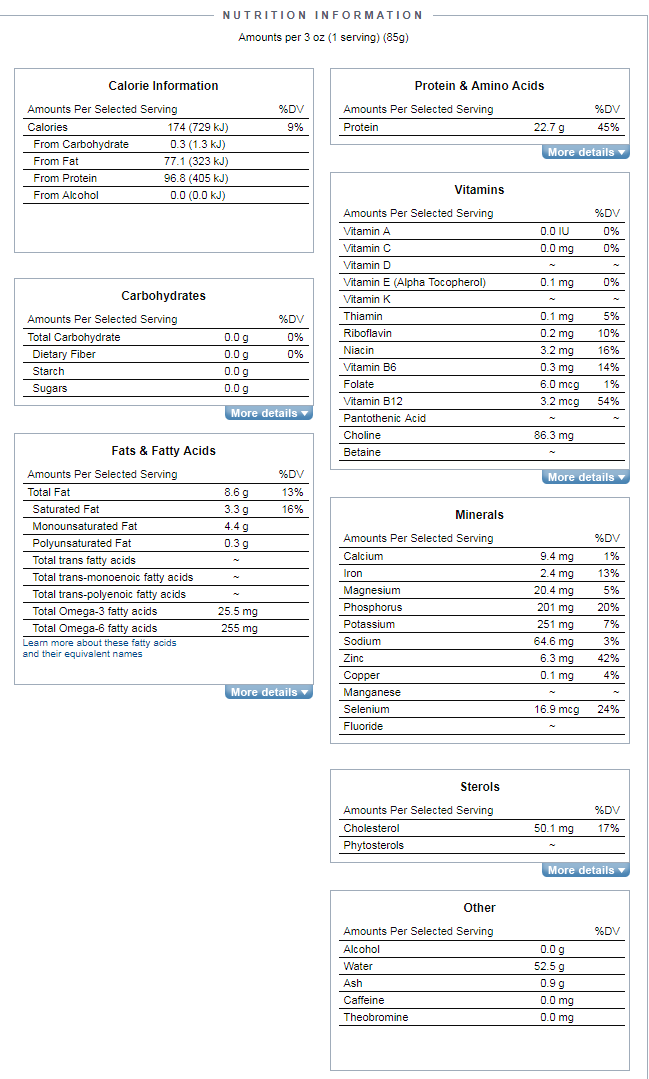
Steak Nutrition Profile via Nutrition Data
Steak Health Benefits
As mentioned above, by eating a piece of steak meat, you don’t just get some fats, carbs, and calories. You also get the following:
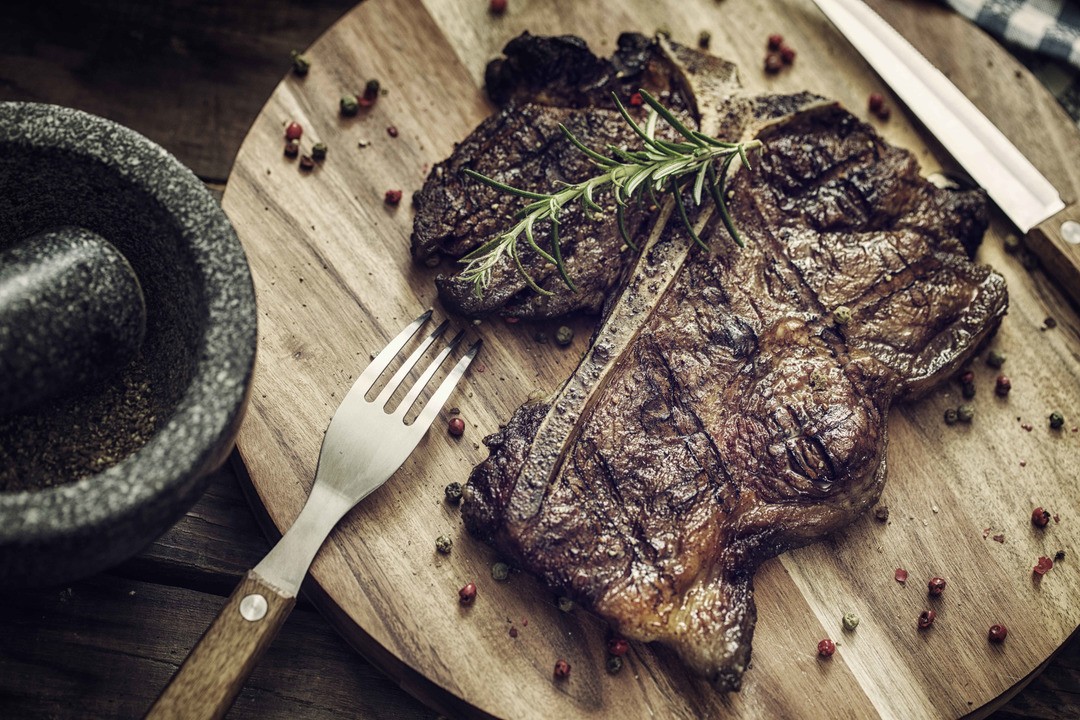
Protein
One of the most known health benefits you can have in one piece of meat is protein. For instance, an 8 oz. sirloin steak can already give you enough protein to reach the suggested daily intake for an average adult. Proteins have amino acids, which you need for muscle building and repair. Protein also makes someone feels full, so it effectively satisfies your hunger longer.
B vitamins
Yes, there is an abundance of B vitamins within your steak. Some positive results it brings include: helping your body digest food more effectively, helping maintain your immune system, and your nervous system functioning. Aside from this, vitamin B12 is known to help prevent cancers and heart disease. B vitamins also contain riboflavin that helps your nails, skin, and eyes to be healthy.
Iron
3 oz. of steak provides you 2.4 mg of iron, to help you reenergize. Iron is essential for your blood, which carries oxygen to lungs. When you lack iron, this can cause serious diseases like fatigue, loss of concentration, anemia, and some behavioral problems.
Health Concerns
While it is true that a steak can give you a good amount of protein and other minerals, there is a certain amount of research that suggest health concerns you get from eating steaks.
Heart disease
There has been a good amount of research that links heart disease and eating red meat. This is due to the cholesterol that you get from eating meats, especially meats that are processed and those that contain much fat.
Another cause that some researchers are pointing out is the salt that processes meats have. According to Simin Liu, MD, ScD at Brown University, sodium is a potential factor for high blood pressure that elevates the risk for heart disease. Other causes might also be the fats and the iron that you get from eating steaks.
Stroke
Because of the nitrates and nitrites from salt, like heart disease, some research has been linking stroke to eating red meat. A review found that for every serving increase in red meat in your diet, stroke also increases by 13% and 15% especially when the red meat is processed.
Diabetes
According to some research, every red meat increase of intake, the risk of type 2 diabetes goes up to 18%. Again, this is specifically caused by processed meats that contain chemicals. These chemicals are toxic to the cells in the pancreas, which produces our insulin.
For more information about the risks that researchers link with eating red meat, read Health Concerns Linked to Red Meat.
FAQ
How can i tell if a steak is spoiled and dangerous?
What rub to use for a top sirloin petite steak?
What are the best ingredients for a steak sauce?
Why do high-end restaurants make better steaks compare to steaks at home?
Why do chefs wash their steaks the night before cooking?
Will eating a whole raw steak make me sick?
Resources and Further Reading
- Omaha Steak’s Preparation Guide
- Amazing Rib’s Thermodynamics of Cooking and Cooking Methods
- The Kitchen’s 27 Dishes Great for Grilled Steaks
- Wikipedia’s Steak information
- Dave UKTV’s Things You Need to Know about Steaks
- Delishably’s Different Cuts of Beef
- Food’s Broiling a Perfect Steak
- Food Network’s How to Pick the Right Cut
- Food Hacks’ One Thing You’re Not Doing for Perfect Steaks
- Prevention’s Health Concerns Linked to Red Meat
- Nutrition Data’s Beef Health Profile
- Men’s Health’s Slicing Steak the Right Way
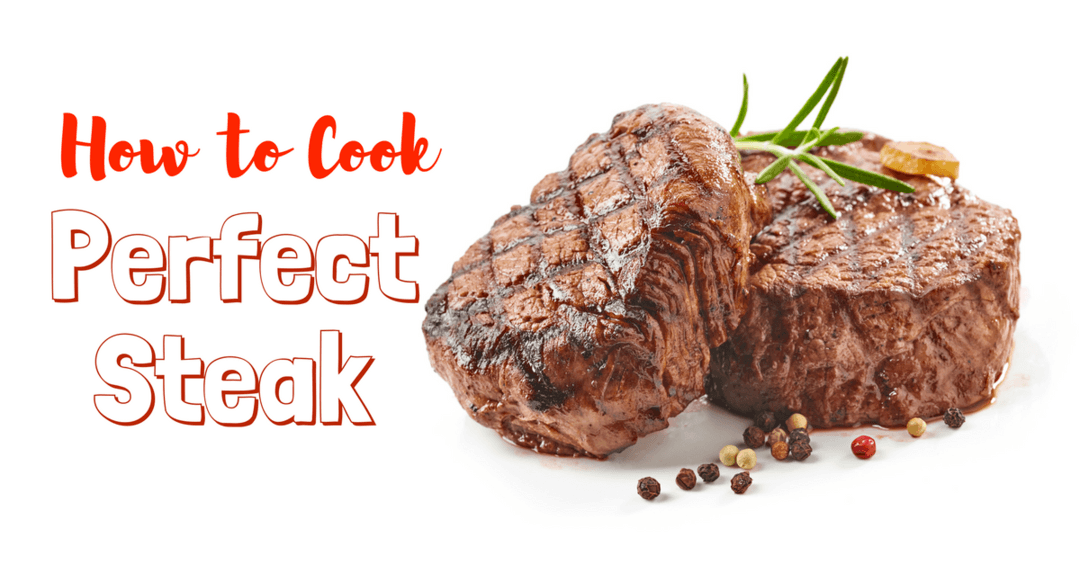















Leave a Reply